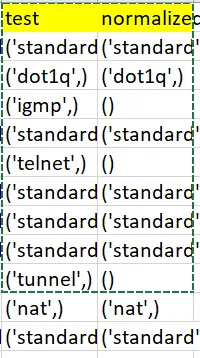我在客服工作,正在使用scikit-learn来预测我们的工单的标签,给定一个训练集(大约有40,000个工单)。我使用基于这个分类模型。然而,它对我的测试集的工单仅预测出“()”这个标签,尽管在训练集中没有一个工单是没有标签的。我的标签训练数据是一个列表的列表,例如:
这是我用于构建模型的相关代码部分:
然而,"predicted"会给出一个类似于以下列表的列表:
tags_train = [['international_solved'], ['from_build_guidelines my_new_idea eligibility'], ['dropbox other submitted_faq submitted_help'], ['my_new_idea_solved'], ['decline macro_backer_paypal macro_prob_errored_pledge_check_credit_card_us loading_problems'], ['dropbox macro__turnaround_time other plq__turnaround_time submitted_help'], ['dropbox macro_creator__logo_style_guide outreach press submitted_help']]
尽管我的工单描述的训练数据只是一串字符串,例如:
descs_train = ['description of ticket one', 'description of ticket two', etc]
这是我用于构建模型的相关代码部分:
```
import numpy as np
import scipy
from sklearn.pipeline import Pipeline
from sklearn.feature_extraction.text import CountVectorizer
from sklearn.feature_extraction.text import TfidfTransformer
from sklearn.multiclass import OneVsRestClassifier
from sklearn.svm import LinearSVC
# We have lists called tags_train, descs_train, tags_test, descs_test with the test and train data
X_train = np.array(descs_train)
y_train = tags_train
X_test = np.array(descs_test)
classifier = Pipeline([
('vectorizer', CountVectorizer()),
('tfidf', TfidfTransformer()),
('clf', OneVsRestClassifier(LinearSVC(class_weight='auto')))])
classifier.fit(X_train, y_train)
predicted = classifier.predict(X_test)
然而,"predicted"会给出一个类似于以下列表的列表:
predicted = [(), ('account_solved',), (), ('images_videos_solved',), ('my_new_idea_solved',), (), (), (), (), (), ('images_videos_solved', 'account_solved', 'macro_launched__edit_update other tips'), ('from_guidelines my_new_idea', 'from_guidelines my_new_idea macro__eligibility'), ()]
我不明白为什么它在训练集中没有空标签的情况下会预测出空标签。它难道不应该预测最相近的标签吗?有没有人能推荐一些改进我正在使用的模型的方法?
非常感谢您提前的帮助!
